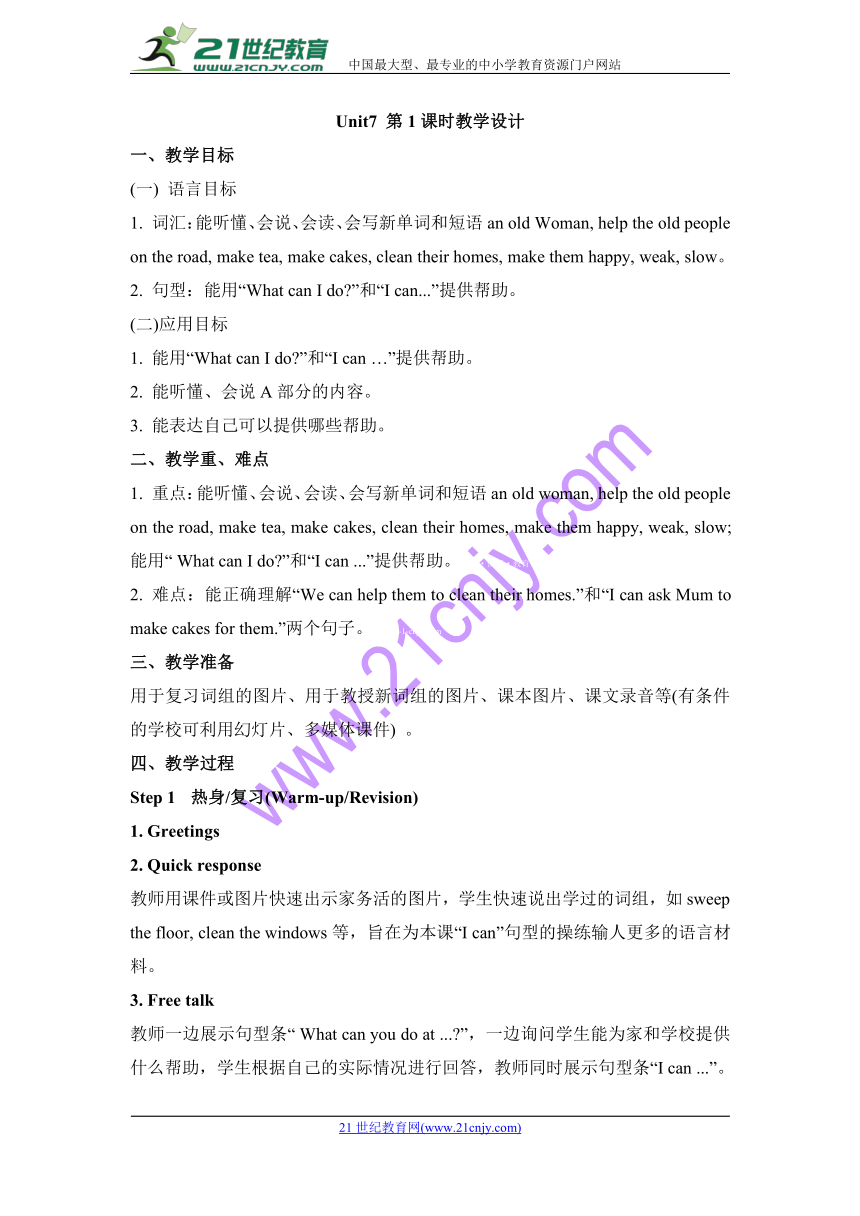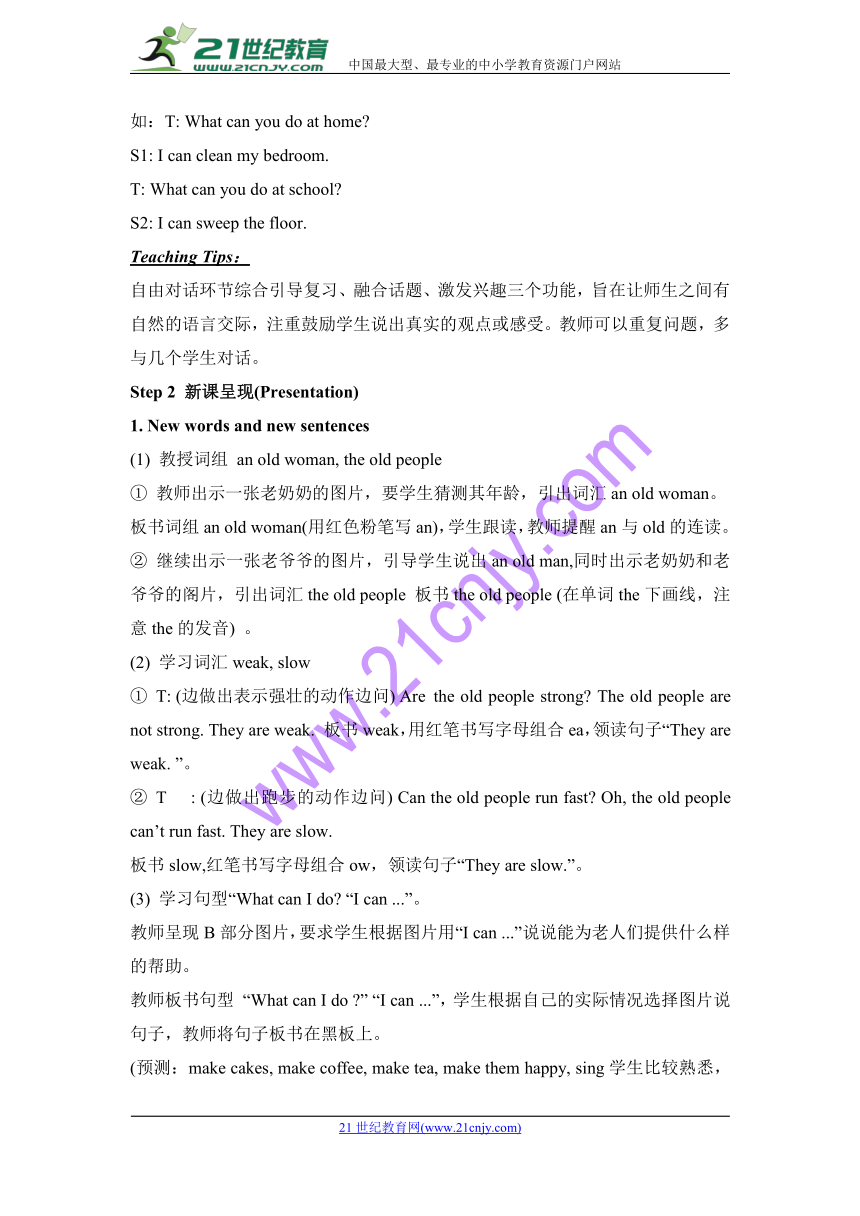Unit 7 What can I do? 第一课时教学设计
文档属性
| 名称 | Unit 7 What can I do? 第一课时教学设计 |  | |
| 格式 | zip | ||
| 文件大小 | 122.5KB | ||
| 资源类型 | 教案 | ||
| 版本资源 | 湘少版 | ||
| 科目 | 英语 | ||
| 更新时间 | 2018-06-12 20:09:41 | ||
图片预览


文档简介
Unit7 第1课时教学设计
一、教学目标
(一) 语言目标
1. 词汇:能听懂、会说、会读、会写新单词和短语an old Woman, help the old people on the road, make tea, make cakes, clean their homes, make them happy, weak, slow。
2. 句型:能用“What can I do?”和“I can...”提供帮助。
(二)应用目标
1. 能用“What can I do?”和“I can …”提供帮助。
2. 能听懂、会说A部分的内容。
3. 能表达自己可以提供哪些帮助。
二、教学重、难点
1. 重点:能听懂、会说、会读、会写新单词和短语an old woman, help the old people on the road, make tea, make cakes, clean their homes, make them happy, weak, slow; 能用“ What can I do?”和“I can ...”提供帮助。【21·世纪·教育·网】
2. 难点:能正确理解“We can help them to clean their homes.”和“I can ask Mum to make cakes for them.”两个句子。www-2-1-cnjy-com
三、教学准备
用于复习词组的图片、用于教授新词组的图片、课本图片、课文录音等(有条件的学校可利用幻灯片、多媒体课件) 。2-1-c-n-j-y
四、教学过程
Step 1 热身/复习(Warm-up/Revision)
1. Greetings
2. Quick response
教师用课件或图片快速出示家务活的图片,学生快速说出学过的词组,如sweep the floor, clean the windows等,旨在为本课“I can”句型的操练输人更多的语言材料。21*cnjy*com
3. Free talk
教师一边展示句型条“ What can you do at ...?”,一边询问学生能为家和学校提供什么帮助,学生根据自己的实际情况进行回答,教师同时展示句型条“I can ...”。
如:T: What can you do at home?
S1: I can clean my bedroom.
T: What can you do at school?
S2: I can sweep the floor.
Teaching Tips:
自由对话环节综合引导复习、融合话题、激发兴趣三个功能,旨在让师生之间有自然的语言交际,注重鼓励学生说出真实的观点或感受。教师可以重复问题,多与几个学生对话。21世纪教育网
Step 2 新课呈现(Presentation)
1. New words and new sentences
(1) 教授词组 an old woman, the old people
① 教师出示一张老奶奶的图片,要学生猜测其年龄,引出词汇an old woman。
板书词组an old woman(用红色粉笔写an),学生跟读,教师提醒an与old的连读。
② 继续出示一张老爷爷的图片,引导学生说出an old man,同时出示老奶奶和老爷爷的阁片,引出词汇the old people 板书the old people (在单词the下画线,注意the的发音) 。21cnjy.com
(2) 学习词汇weak, slow
① T: (边做出表示强壮的动作边问) Are the old people strong? The old people are not strong. They are weak. 板书weak,用红笔书写字母组合ea,领读句子“They are weak. ”。【21cnj*y.co*m】
② T : (边做出跑步的动作边问) Can the old people run fast? Oh, the old people can’t run fast. They are slow.【21教育名师】
板书slow,红笔书写字母组合ow,领读句子“They are slow.”。
(3) 学习句型“What can I do? “I can ...”。
教师呈现B部分图片,要求学生根据图片用“I can ...”说说能为老人们提供什么样的帮助。
教师板书句型 “What can I do ?” “I can ...”,学生根据自己的实际情况选择图片说句子,教师将句子板书在黑板上。21·世纪*教育网
(预测:make cakes, make coffee, make tea, make them happy, sing学生比较熟悉,难点是引导学生用完整的句子突破clean their homes, help them on the road, go on and off the bus) 学生朗读板书的句子。【21教育】
(4) 单词、句型操练。
教师可创设其他情境,学生根据情境运用所学单词和句型表达。
2. The text
课文学习,教师可分步骤循序渐进地引导学生熟悉课文。
(1) Listen and count
不打开书,只听音。听音前,给出任务:
How many things can the children do for the old people?www.21-cn-jy.com
(2) Listen and find
打开书,听第二遍,画出5件孩子们能提供的帮助,检查刚才自己听到的是否正确。
(3) Listen and repeat
听音,跟读,注意himself的发音和“What can I do?”的连读,引导学生正确模仿,提醒学生注意模仿语调。21教育网
(4) Read and act
出示没有文字的课文插图,引导学生说和表演。
Step 3 趣味操练(Practice)
1. Let’s chant
教师将所学单词组成chant,分组练习。
I can help the old. I can help the old.
What can I do? I can clean their homes.
What can I do? I can help them on the road.
What can I do? I can sing and talk.
What about you? What can you do?
2. 情境创设:学校要选学生代表去福利院开展“关爱老弱病残幼”的少先队活动,说说你能做什么。4?8人一组上台进行竞选,竞选上的一组将被评为优秀少先队组。21·cn·jy·com
如:We are_______!
We want to help________.
What can I do? I can________.
Teaching Tips :
构建语言支架是一种让学生尝试输出完整语篇的方式,对于基础一般的学生,支架能辅助其表达,但是,对于基础好的学生,教师可适当拆解支架,鼓励其表达更多内容。2·1·c·n·j·y
Step 4 作业布置(Homework)
1. 听一听,读一读:听读课文A、B部分。
2. 写一写:想想你能为老年人做些什么,然后写下来,越多越好。
一、教学目标
(一) 语言目标
1. 词汇:能听懂、会说、会读、会写新单词和短语an old Woman, help the old people on the road, make tea, make cakes, clean their homes, make them happy, weak, slow。
2. 句型:能用“What can I do?”和“I can...”提供帮助。
(二)应用目标
1. 能用“What can I do?”和“I can …”提供帮助。
2. 能听懂、会说A部分的内容。
3. 能表达自己可以提供哪些帮助。
二、教学重、难点
1. 重点:能听懂、会说、会读、会写新单词和短语an old woman, help the old people on the road, make tea, make cakes, clean their homes, make them happy, weak, slow; 能用“ What can I do?”和“I can ...”提供帮助。【21·世纪·教育·网】
2. 难点:能正确理解“We can help them to clean their homes.”和“I can ask Mum to make cakes for them.”两个句子。www-2-1-cnjy-com
三、教学准备
用于复习词组的图片、用于教授新词组的图片、课本图片、课文录音等(有条件的学校可利用幻灯片、多媒体课件) 。2-1-c-n-j-y
四、教学过程
Step 1 热身/复习(Warm-up/Revision)
1. Greetings
2. Quick response
教师用课件或图片快速出示家务活的图片,学生快速说出学过的词组,如sweep the floor, clean the windows等,旨在为本课“I can”句型的操练输人更多的语言材料。21*cnjy*com
3. Free talk
教师一边展示句型条“ What can you do at ...?”,一边询问学生能为家和学校提供什么帮助,学生根据自己的实际情况进行回答,教师同时展示句型条“I can ...”。
如:T: What can you do at home?
S1: I can clean my bedroom.
T: What can you do at school?
S2: I can sweep the floor.
Teaching Tips:
自由对话环节综合引导复习、融合话题、激发兴趣三个功能,旨在让师生之间有自然的语言交际,注重鼓励学生说出真实的观点或感受。教师可以重复问题,多与几个学生对话。21世纪教育网
Step 2 新课呈现(Presentation)
1. New words and new sentences
(1) 教授词组 an old woman, the old people
① 教师出示一张老奶奶的图片,要学生猜测其年龄,引出词汇an old woman。
板书词组an old woman(用红色粉笔写an),学生跟读,教师提醒an与old的连读。
② 继续出示一张老爷爷的图片,引导学生说出an old man,同时出示老奶奶和老爷爷的阁片,引出词汇the old people 板书the old people (在单词the下画线,注意the的发音) 。21cnjy.com
(2) 学习词汇weak, slow
① T: (边做出表示强壮的动作边问) Are the old people strong? The old people are not strong. They are weak. 板书weak,用红笔书写字母组合ea,领读句子“They are weak. ”。【21cnj*y.co*m】
② T : (边做出跑步的动作边问) Can the old people run fast? Oh, the old people can’t run fast. They are slow.【21教育名师】
板书slow,红笔书写字母组合ow,领读句子“They are slow.”。
(3) 学习句型“What can I do? “I can ...”。
教师呈现B部分图片,要求学生根据图片用“I can ...”说说能为老人们提供什么样的帮助。
教师板书句型 “What can I do ?” “I can ...”,学生根据自己的实际情况选择图片说句子,教师将句子板书在黑板上。21·世纪*教育网
(预测:make cakes, make coffee, make tea, make them happy, sing学生比较熟悉,难点是引导学生用完整的句子突破clean their homes, help them on the road, go on and off the bus) 学生朗读板书的句子。【21教育】
(4) 单词、句型操练。
教师可创设其他情境,学生根据情境运用所学单词和句型表达。
2. The text
课文学习,教师可分步骤循序渐进地引导学生熟悉课文。
(1) Listen and count
不打开书,只听音。听音前,给出任务:
How many things can the children do for the old people?www.21-cn-jy.com
(2) Listen and find
打开书,听第二遍,画出5件孩子们能提供的帮助,检查刚才自己听到的是否正确。
(3) Listen and repeat
听音,跟读,注意himself的发音和“What can I do?”的连读,引导学生正确模仿,提醒学生注意模仿语调。21教育网
(4) Read and act
出示没有文字的课文插图,引导学生说和表演。
Step 3 趣味操练(Practice)
1. Let’s chant
教师将所学单词组成chant,分组练习。
I can help the old. I can help the old.
What can I do? I can clean their homes.
What can I do? I can help them on the road.
What can I do? I can sing and talk.
What about you? What can you do?
2. 情境创设:学校要选学生代表去福利院开展“关爱老弱病残幼”的少先队活动,说说你能做什么。4?8人一组上台进行竞选,竞选上的一组将被评为优秀少先队组。21·cn·jy·com
如:We are_______!
We want to help________.
What can I do? I can________.
Teaching Tips :
构建语言支架是一种让学生尝试输出完整语篇的方式,对于基础一般的学生,支架能辅助其表达,但是,对于基础好的学生,教师可适当拆解支架,鼓励其表达更多内容。2·1·c·n·j·y
Step 4 作业布置(Homework)
1. 听一听,读一读:听读课文A、B部分。
2. 写一写:想想你能为老年人做些什么,然后写下来,越多越好。
同课章节目录
- Unit 1 What did you do during the holidays?
- Unit 2 Katie always gets up early.
- Unit 3 I like my compute
- Unit 4 The Mid-Autumn Festival is coming...
- Unit 5 It will be sunny and cool tomorrow
- Unit 6 I will bring a big bottle of orange juice
- Unit 7 What can I do?
- Unit 8 We shouldn't waste wate
- Unit 9 This bird is bigger than fist one...
- Unit 10 I don't feel well today
- Unit 11 Shall we go to the theatre?
- Unit12 It's Christmas again!
